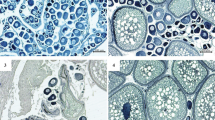Abstract
Postelsia palmaeformis were collected from the lower intertidal at Pigeon Point, California, USA, in May 1987, and the proximate composition and allocation of energy to the various body components were determined. The holdfast and stipe have a proximate composition (% dry weight) of ca. 40% ash, 5.3% protein, 1% lipid, 2% soluble carbohydrate, and 55% insoluble carbohydrate. The fronds have a proximate composition of ca. 25% ash, 6.5% protein, 2% lipid, 3% soluble carbohydrate, and 65% insoluble carbohydrate. The energetic level was ca. 12 kJ g-1 dry wt and ca. 19 kJ g-1 ash-free dry wt. The relative proportion of three plant components varied, comprising 26, 39, and 35% wet wt and 20, 42, and 38% kJ for the holdfast, stipe, and fronds, respectively. A plant with a basal stipe diameter of 33 mm contains 114 g wet wt and 266 kJ. The maximal density found in May 1987 was 826 plants, 49 301 g wet wt, and 106 157 kJ m-2.P. palmaeformis differs in these characteristics from another intertidal pheophyte,Durvillaea antarctica, that is found in a high-energy intertidal zone.
Similar content being viewed by others
Literature cited
Brody, S. (1945). Bioenergetics and growth. Hafner Press, New York.
Calow, P. (1984). Economics of ontogeny — adaptational aspects. In: Shorrocks, B. (ed.) Evolutionary ecology. Blackwell Scientific Publications, Oxford, p. 81–104
Connell, J. H. (1986). Variation and persistence of rocky shore populations. In: Moore, P. G., Seed, R. (eds.) The ecology of rocky shores. Columbia University Press, New York, p. 57–69
Dayton, P. K. (1973). Dispersion, dispersal, and persistence of the annual intertidal alga,Postelsia palmaeformis Ruprecht. Ecology 54: 433–438
Dubois, M., Gilles, K. A., Hamilton, J. K., Rebers, P. A., Smith, R. (1956). Colorimetric method for the determination of sugars and related substances. Analyt. Chem. 28: 350–356
Freeman, N. K., Lindgren, F. T., Ng, N. C., Nichols, A. V. (1957). Infrared spectra of some lipoproteins and related lipids. J. biol. Chem. 227: 449–464
Fritsch, F. E. (1952). The structure and reproduction of algae. Vol. II. Cambridge University Press, Cambridge
Gornall, A. C., Bardawill, C. J., David, M. M. (1949) Determination of serum proteins by means of the biuret reaction. J. biol. Chem. 117: 751–766
Jackson, G. A., James, D. E., North, W. J. (1985) Morphological relationships among fronds of giant kelpMacrocystis pyrifera off La Jolla, California. Mar. Ecol. Prog. Ser. 26: 261–270
Kain (Jones), J. M. (1982). Morphology and growth of the giant kelpMacrocystis pyrifera in New Zealand and California. Mar. Biol. 67: 143–157
Lawrence, J. M. (1986). Proximate composition and standing crop ofDurvillaea antarctica (Pheophyta) in the Bay of Morbihan, Kerguelen (South Indian Ocean). Mar. Ecol. Prog. Ser. 33: 1–5
Leigh, E. G., Jr., Paine, R. T., Quinn, J. F., Suchanek, T. H. (1987) Wave energy and intertial productivity. Proc. natn. Acad. Sci. U.S.A. 84: 1314–1318
Lowry, O. H., Rosebrough, N. J., Farr, A. L., Randall, R. J. (1951) Protein measurement with the Folin phenol reagent. J. biol. Chem. 193: 265–275
Nicholson, N. L. (1970). Field studies on the giant kelpNereocystis. J. Phycol. 6: 177–182
Paine, R. T. (1971). The measurement and application of the calorie to ecological problems. A. Rev. Ecol. Syst. 2: 145–164
Paine, R. T. (1979) Disaster, catastrophe, and local persistence of the sea palmPostelsia palmaeformis. Science, N. Y. 205: 685–687
Paine, R. T., Vadas, R. L. (1969). Calorific values of benthic marine algae and their postulated relation to invertebrate food preference. Mar. Biol. 4: 79–86
Ricketts, E. F., Calvin, J. (1968). Between Pacific tides, 3rd ed., revised. Stanford University Press, Stanford
Russell, G. (1986). Variation and natural selection in marine macroalgae. Oceanogr. mar. Biol. A. Rev. 24: 309–377
Santelices, B., Castilla, J. C., Cancino, J., Schmiede, P. (1980). Comparative ecology ofLessonia nigrescens andDurvillaea antarctica (Phaeophyta) in central Chile. Mar. Biol. 59: 119–132
Stephenson, T. A., Stephenson, A. (1972). Life between tidemarks on rocky shores. W. H. Freeman & Co. San Francisco
Author information
Authors and Affiliations
Additional information
Communicated by J. M. Lawrence, Tampa
Rights and permissions
About this article
Cite this article
Lawrence, J.M., McClintock, J.B. Allocation of organic material and energy to the holdfast, stipe, and fronds inPostelsia palmaeformis (Phaeophyta: Laminariales) on the California coast. Mar. Biol. 99, 151–155 (1988). https://doi.org/10.1007/BF00644990
Accepted:
Issue Date:
DOI: https://doi.org/10.1007/BF00644990




